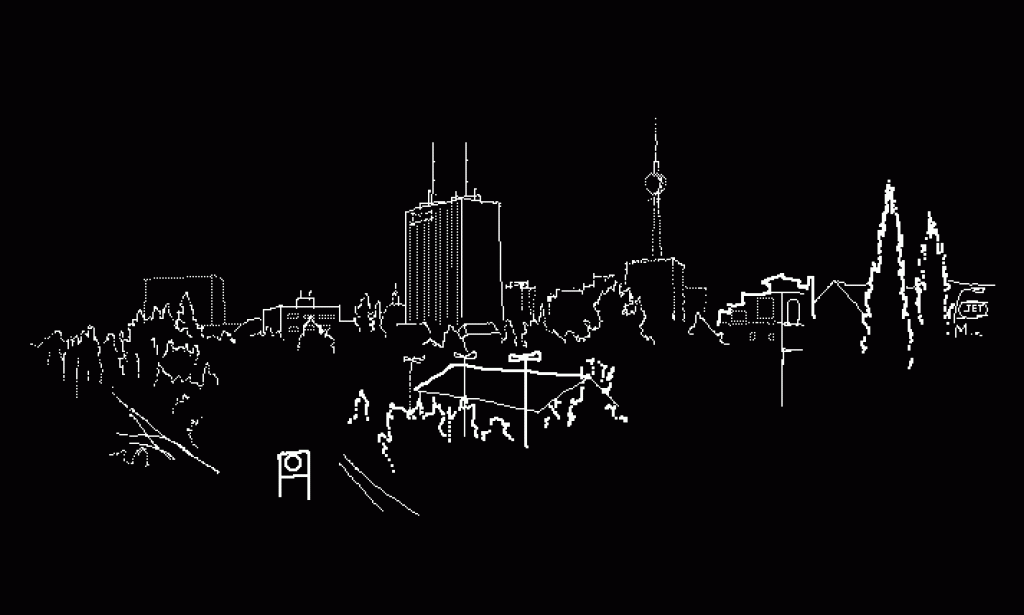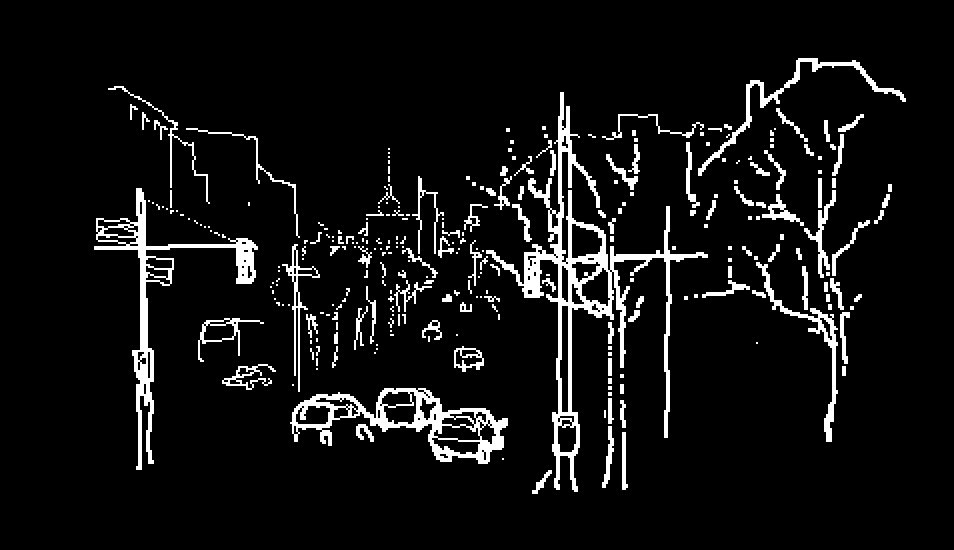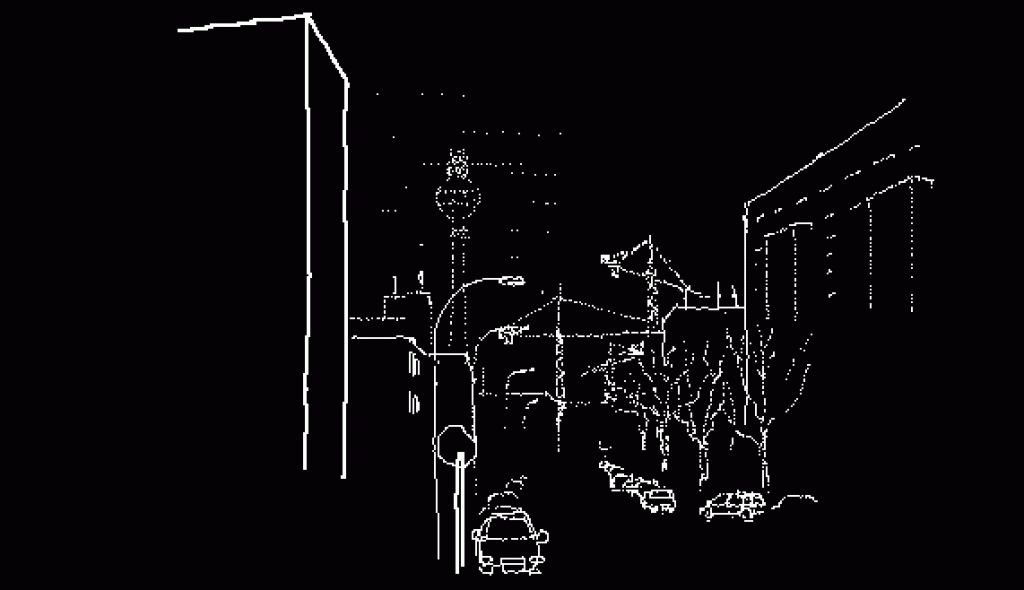A recent arrival describes Berlin in a series of small scenes – described both through text and through simple digital line-drawings. The drawings and text were dispatched out by email, but also appeared as laser-etched wooden panels in the exhibition ‘Wandering Rocks’ at Gimpel Fils Gallery, in London.
Traveling clockwise around the city through its different areas, the drawings always depict somewhere within their frame Berlin’s Fernsehturm (or TV Tower). The vignettes describe a giant circle around the city – slowly circling around the TV Tower and its unseen revolving restaurant.
***
Kreuzberg
N.52°29.280, E.13°22.336

In the summer the no-man’s-land by the S-Bahn tracks is a secret garden. Follow the path off the main road, through the thick undergrowth, past a derelict building and eventually you emerge into a sunlit oasis. Berlin invisible behind the dense trees.
White sand has been imported, a makeshift bar had been constructed and music drifts across the 16 beach volleyball courts. Every now and then an S-Bahn train rumbles past on its way to the city’s centre.
Now though chunks of ice have been lying on the pavement for weeks. I’ve never thought of water as a proper solid before. Ice is supposed to be something that is there in the morning or comes from the fridge – a fragile temporary condition not a stable rock for. I’ve seen ice landscapes in far-flung places but I’ve never seen it take over a city
Schöneberg
N.52°29.970, E.13°21.248

The hard sun slants through the windows of the station – two storeys above the Nollendorfplatz intersection. Down the centre of the wide streets, above Kreuzberg and Schöneberg, the elevated U1 railway rattles its way through the four storey buildings.
With their backs to the view out over the city, the waiting Berliners gaze at the tracks or the people opposite. Their breath forms back-lit clouds evaporating in the sharp light.
Wilmersdorf
N.52°29.290 W.13°18.398

Berlin is a shrinking city. A taxi driver tells me that before WW1 the metropolis had 5 million inhabitants and now it only has three. The town feels half empty and even the rush hour fails to rush.
Charlottenburg
N.52°30.748, E.13°19.240

One of my favourite words is ‘Auspuff’. German words have this ridiculous way of sounding like the things that they describe. ‘Auspuff’ means exhaust-pipe and its no nonsense poetry feels strangely beautiful.
I love being wrong and misunderstood. I have new eyes and a fancy-dress tongue. Its hilarious that I can speak these sensuous, gurgling words and people act as if they understand – words that are so bodily they feel like you should only speak them in private.
Moabit
N.52°31.535, E.13°20.332

Nobody likes Moabit. This central borough is right next to Tiergarten (the large park right at the centre of the city) but somehow it seems cursed.

With so much space, so few people and so little work – there’s no pressure to fill the void. In London a disused underground toilet will get redeveloped into flats. In Moabit it will just remain a disused toilet.

Wedding
N.52°32.552, E.13°21.941

The sun is a milky-white behind icy clouds but it feels a little warmer today. Dressing for cycling is a careful process. The extremities of the body (toes, fingers and nose) need careful padding but the torso is prone to becoming too hot.
It’s a revelation to me that after surviving minus 22°C, it is possible that minus 4°C actually feels balmy.
Prinzlauerberg
N.52°32.302, E.13°23.766

There isn’t much left to tell you when you’ve crossed the border into the East. People tell you stories of the wasteland patrolled by dogs that were attached to overhead wires – running up and down the no-man’s land between the two super-powers.
Now though, it’s only when you see the tram lines in the road that you know you’ve entered East. The modernising West ripped out the tracks years ago, and now its too expensive to put them back.
Mitte no.1
N.52°31.745, E.13° 24.614

The German moon is oblong. I cycle at night with its light at the edge of my vision, skimming above the roofs. In fact it is the illuminated sign on another crane – balancing itself above the rapidly changing skyline of the east.
Friedrichshain
N.52°30.936, E.13°25.597

Friedrichshain is the new Prinzlauerberg, which was the new Mitte. In the East everything is changing – even the ‘Plattenbau’. Literally meaning ‘plate-buildings’ these prefabricated soviet monsters are becoming sought-after. The beautiful lumps of Stalinist concrete that line Karl Marx Allee still house some of the original tenants. With a special key, though, the lift now goes up one more floor to the glass penthouses that have landed on the roof.
Mitte no.2
N.52°30.929, E.13°24.006

The ‘Nebelkrähe’ or fog-crows are flying beneath the low clouds. You see the birds everywhere in Berlin – hopping, surly silhouettes against the snow. They seem bolder than their London counterparts, they stop to look at you and hunch their foggy-silver shoulders.
The ‘Palast der Republik’ is being demolished. The futuristic DDR parliament building is being levelled to make way, first for the world cup and then to rebuild an ornate replica of a lost Prussian palace. The future turned out to be riddled with asbestos and now its being replaced with past.